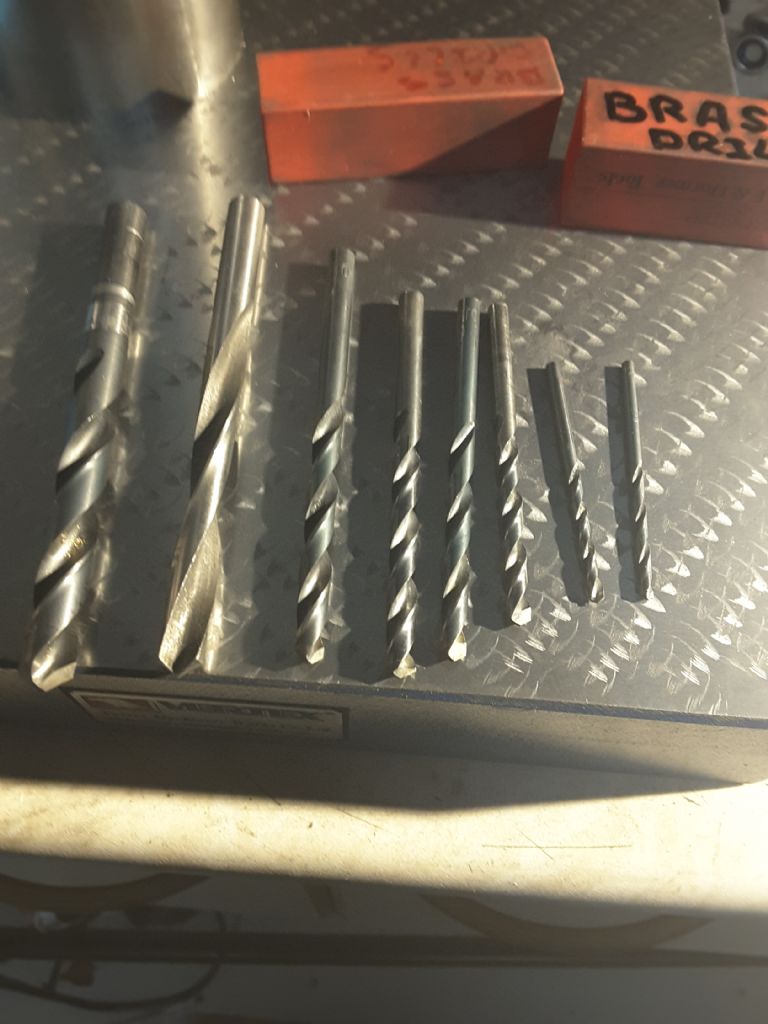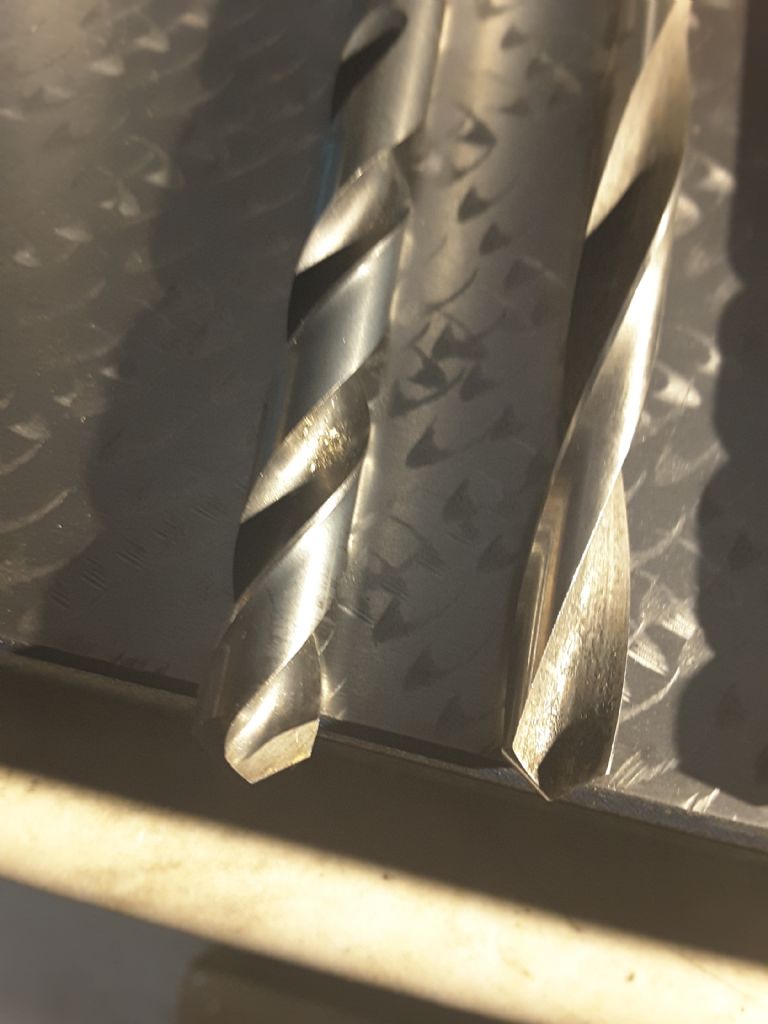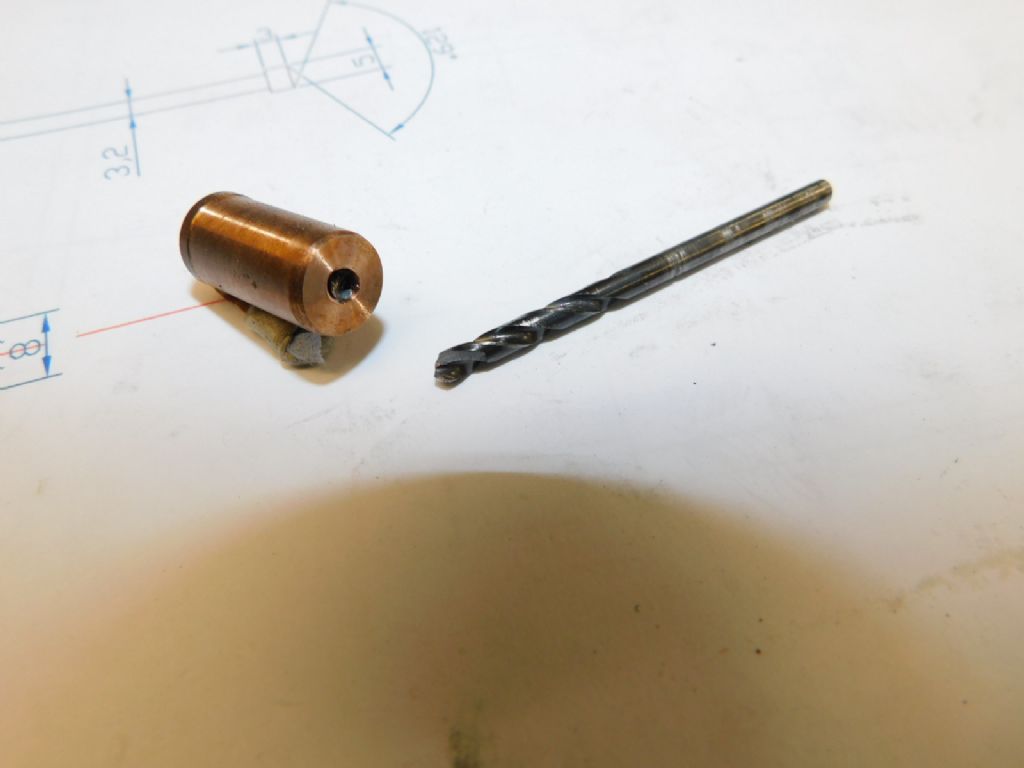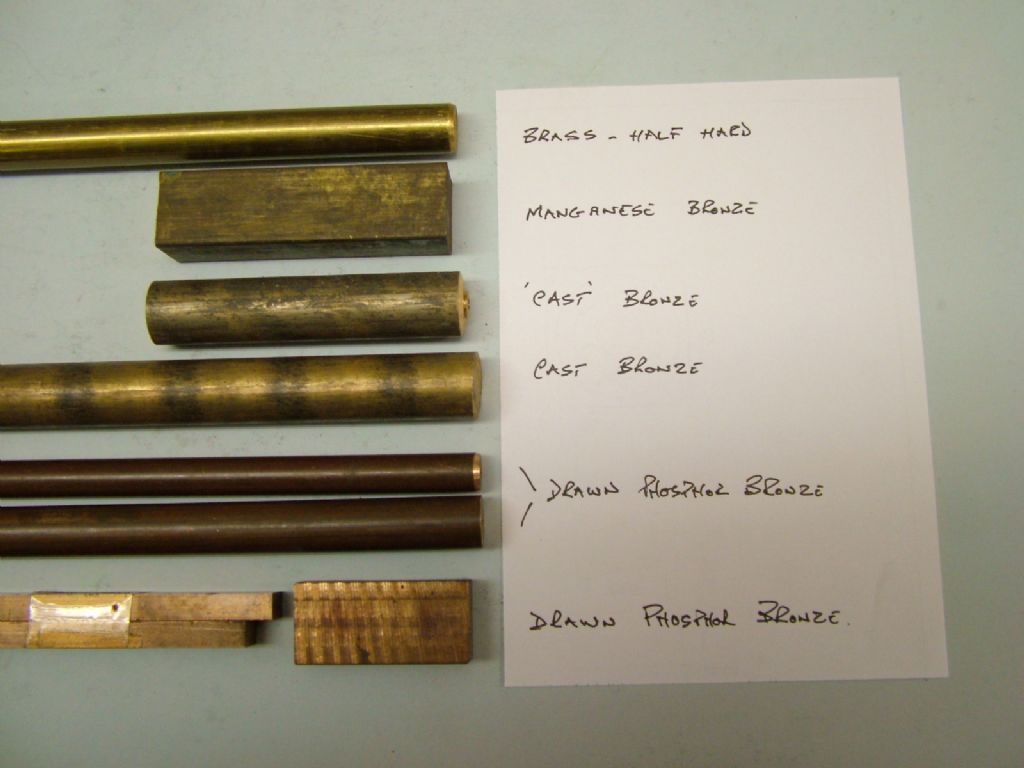Machining phosphor bronzes
| Martin Dowing | 03/03/2021 22:45:22 |
356 forum posts 8 photos | Some of them are nice and others are pig. I got one difficult sample. It turns well to a nice finish, will part off and drill with small (up to 5-8 mm drills). However drilling with larger drills or slot drills ends up in failure, regardless how sharp they are. Regrinding doesnt help either. I predrilled 8mm and tried to open up bore up to 12 mm and this was of most horrible drilling experiences I ever had, even if successful after long struggling. Drill just doesnt want to cut and that's it. It is not a very hard material either but now I better understand why it is so good for bearings. Do you have any ideas why it behaves so or know tricks around it? |
| Lee Rogers | 04/03/2021 07:55:28 |
203 forum posts | Try a pilot hole no larger than the web on the next drill , it will reduce the tendancy to grab and pull in, and don't spare the cutting fluid. I've also heard that stopping occasionally and cooling the job helps reduce the grabbing. Cutwell do drills with a modified profile for bronze can't say I've used one though. |
| David George 1 | 04/03/2021 08:23:01 |
2110 forum posts 565 photos | I modify the drills I use on brass and bronze. I grind the front cutting edge to give a flat cutting face which stops the drill grabbing and use a cutting oil or coolant. David
|
| Mike Hurley | 04/03/2021 08:35:05 |
| 530 forum posts 89 photos | Fairly recently I had an issue with a piece of PB when using a brand new slitting saw. It was quite thin (about 1mm) and I ran it pretty much as I would for brass. It contstantly struggled, jammed ( tried with and without lubricant) but finally siezed and stripped several teeth off the saw. In desperation I stuck it in a vise and attacked it with a hacksaw (32 tpi blade) and it cut like butter! So if its heat or 'springiness' causing the seizures, slow and steady seems to be the byword. regards Mike
|
| Ramon Wilson | 04/03/2021 08:45:41 |
1655 forum posts 617 photos | If the bronze used by Martin is the drawn pinkish colour hard bronze I think it may be, the one thing you do not want to do is back a drill off as you would for brass to prevent snatching. We've dealt with this issue recently somewhere - drawn bronze is notoriously difficult to drill due to heat build up and gripping the tool - either drill or reamer. It's self 'promoting' too in that it work hardens very quickly if a tool is not razor sharp so increasing friction and increasing heat extremely rapidly. If flood coolant is available then that does help but for those without this can be one machining op fraught with problems Step drilling is an issue unless as Lee say the previous hole is no wider that the web of the next drill. Very sharp edges are required and it can help to grind one side of the drill slightly wider than the other. This material always presents challenges when drilling - I have found it is much better to get as large a hole in as possible with one drilling from a very small pilot hole then bore it to size. Boring for some reason does not create any issues - providing the tool is sharp. Tug |
| Neil Lickfold | 04/03/2021 09:09:13 |
| 1025 forum posts 204 photos | One trick is to make the drill, cut oversize. Just slightly offset sharpen the drill. Some do work harden, and is a time when you do not want to be cutting dry. Water bases coolants are great for these sort of situations.The modern synthetic coolants have something in them that help in high pressure situations like drilling. A split point drill to the nearest you have and then bore from there. Step drilling does not seem to be as effective as drilling from solid. For a 12mm hole, use a 11.5mm drill straight in from the centre or starting drill. Pre drilling even at 4mm will make the material often work harden. Neil |
| Nigel McBurney 1 | 04/03/2021 09:31:30 |
1101 forum posts 3 photos | There is a comment in the initial post that phos bronze is good for bearings,phos bronze is not a god bearing material,the only time phos bronze can be used a bearing for shafts,is when the shaft is very hard and ground and there is a lot of lubricant,leaded bronze is a far superior bearing material. One use is where steel or iron pivoting levers with limited motion are bushed with phos bronze to make the motion easier and to prevent seizure from corrosion in exposed situations, |
| Bo'sun | 04/03/2021 09:54:53 |
| 754 forum posts 2 photos | Will "slow helix" drill bits work better than "standard" drill bits in phosphor bronze? |
| Mike Hurley | 04/03/2021 09:58:17 |
| 530 forum posts 89 photos | Have a look at Neil Wyatt's web site ( Stub Mandrel ), in the model engineering section there's an excellent overview of materials and their working properties - including PB. Hope that helps
Edited By Mike Hurley on 04/03/2021 09:58:57 |
| Andrew Johnston | 04/03/2021 10:00:00 |
7061 forum posts 719 photos | Posted by Bo'sun on 04/03/2021 09:54:53:
Will "slow helix" drill bits work better than "standard" drill bits..... They work fine for me in bronze and brass. Andrew |
| Martin Dowing | 04/03/2021 22:36:06 |
356 forum posts 8 photos | Many thanks for all your comments. @David, Will try your mehod of drill grinding next time. @Ramon, Yes, that was my phosphor bronze - very much like material you describe. Interestingly turning and parting off, very much like boring is rouble free. It is drilling what is problematic. Did you or anyone else have tried to tap this material btw? Also many thanks for comments of some of you that "small pilot hole is a good pilot hole" and Neil's remarks about usefulness of predrilling in such situation in general. Martin |
| Peter Krogh | 05/03/2021 00:45:35 |
228 forum posts 20 photos | This thread brings up a question I've had: Can silicon bronze be used for boiler bushings, etc. ??? It machines very well. Thanks, Pete |
| Hopper | 05/03/2021 01:00:37 |
7881 forum posts 397 photos | Posted by Martin Dowing on 04/03/2021 22:36:06:...
...Interestingly turning and parting off, very much like boring is rouble free. It is drilling what is problematic. Possibly running the drill at lower rpm would help? Could explain why the smaller drill worked ok but the larger one was spinning too fast if the spindle speed was not reduced to suit? Low speed and keeping the feed up to it so its taking a decent cut and not rubbing will in most cases reduce work hardening. It's impossible to draw hard and fast conclusions about machining "bronze" because even among the phosphor bronze variants there are so many different alloys that all machine differently. You can get leaded phosphor bronze such as Colphos that is made to be machined easily. Others are just plain cows to deal with. Trial and error with any unidentified piece is the only way to really know. |
| not done it yet | 05/03/2021 07:05:11 |
| 7517 forum posts 20 photos | Interestingly turning and parting off, very much like boring is rouble free. You may not have noticed that these cutters all have back-clearance? |
| Ramon Wilson | 05/03/2021 08:26:18 |
1655 forum posts 617 photos | Posted by Martin Dowing on 04/03/2021 22:36:06: Many thanks for all your comments. @David, Will try your mehod of drill grinding next time. @Ramon, Yes, that was my phosphor bronze - very much like material you describe. Interestingly turning and parting off, very much like boring is rouble free. It is drilling what is problematic. Did you or anyone else have tried to tap this material btw? Also many thanks for comments of some of you that "small pilot hole is a good pilot hole" and Neil's remarks about usefulness of predrilling in such situation in general. Martin
Martin, I have made bushes using this material and had no issues with tapping but like any other cutting tool on bronze it does need a good sharp tap for best approach. However as already noted it is the drilling and reaming that brings out the worst in this particular material. I would echo Nigels comment that this material is best suited as a bearing on hardened steel shafts for it can (not neccesarily will, gall and sieze) That said it is what I have made all the bottom end con rod bushes on my diesels and they are running on tough but unhardened EN24T steel without any issues so far. Though theres quite a few pieces of it lying in the drawer, sourced from various shows over the years, it's a material I try to avoid if possible due to the propensity it to seize a drill. It was not that long ago that I had a drill (about 3mm) seize in a piece and snap the drill quicker 'than the eye could see' Several years ago on a similar theme over bronzes I did this to show the differences in basic bronzes likely to be found in a home workshop.
As already said by someone else there are many different 'brasses' - gunmetal, not shown above probably the most used by ME's Where possible I prefer to use manganse bronze for bearings in steam engines. The cast bronze is also an excellent bearing material in combination with leaded steel for slower running bearings . Hope that's of a little further interest - Ramon (Tug) Edited By Ramon Wilson on 05/03/2021 08:28:12 |
Please login to post a reply.
Want the latest issue of Model Engineer or Model Engineers' Workshop? Use our magazine locator links to find your nearest stockist!
Sign up to our newsletter and get a free digital issue.
You can unsubscribe at anytime. View our privacy policy at www.mortons.co.uk/privacy
- *Oct 2023: FORUM MIGRATION TIMELINE*
05/10/2023 07:57:11 - Making ER11 collet chuck
05/10/2023 07:56:24 - What did you do today? 2023
05/10/2023 07:25:01 - Orrery
05/10/2023 06:00:41 - Wera hand-tools
05/10/2023 05:47:07 - New member
05/10/2023 04:40:11 - Problems with external pot on at1 vfd
05/10/2023 00:06:32 - Drain plug
04/10/2023 23:36:17 - digi phase converter for 10 machines.....
04/10/2023 23:13:48 - Winter Storage Of Locomotives
04/10/2023 21:02:11 - More Latest Posts...
- View All Topics
- Reeves** - Rebuilt Royal Scot by Martin Evans
by John Broughton
£300.00 - BRITANNIA 5" GAUGE James Perrier
by Jon Seabright 1
£2,500.00 - Drill Grinder - for restoration
by Nigel Graham 2
£0.00 - WARCO WM18 MILLING MACHINE
by Alex Chudley
£1,200.00 - MYFORD SUPER 7 LATHE
by Alex Chudley
£2,000.00 - More "For Sale" Ads...
- D1-3 backplate
by Michael Horley
Price Not Specified - fixed steady for a Colchester bantam mark1 800
by George Jervis
Price Not Specified - lbsc pansy
by JACK SIDEBOTHAM
Price Not Specified - Pratt Burnerd multifit chuck key.
by Tim Riome
Price Not Specified - BANDSAW BLADE WELDER
by HUGH
Price Not Specified - More "Wanted" Ads...
Do you want to contact the Model Engineer and Model Engineers' Workshop team?
You can contact us by phone, mail or email about the magazines including becoming a contributor, submitting reader's letters or making queries about articles. You can also get in touch about this website, advertising or other general issues.
Click THIS LINK for full contact details.
For subscription issues please see THIS LINK.
Model Engineer Magazine
- Percival Marshall
- M.E. History
- LittleLEC
- M.E. Clock
ME Workshop
- An Adcock
- & Shipley
- Horizontal
- Mill
Subscribe Now
- Great savings
- Delivered to your door
Pre-order your copy!
- Delivered to your doorstep!
- Free UK delivery!















 Register
Register Log-in
Log-in


